Survey methodology is a crucial aspect of conducting accurate and reliable research. It involves various steps, including questionnaire design, data collection methods, and analysis. Creating good survey questions and ensuring proper organization of the questionnaire are key factors in obtaining accurate survey responses. Pilot testing and pretesting the survey can help identify any issues and improve the questionnaire design. Measuring change over time and maintaining consistency in question wording are also important considerations in survey methodology.
Key Takeaways:
- Survey methodology is vital for accurate and reliable research.
- Designing clear and well-organized questionnaires is crucial.
- Pilot testing and pretesting help identify and address issues.
- Consistency in question wording is essential for valid comparisons over time.
- Consider respondent understanding and engagement for optimal survey design.
Questionnaire Design: Creating Effective Survey Questions
Developing a survey questionnaire is a critical step in gathering accurate and meaningful data. To ensure the success of your survey, careful consideration must be given to survey questionnaire design and the creation of effective survey questions.
Identifying Relevant Topics
When designing a survey questionnaire, it is essential to identify the topics that need to be covered. Consider the relevance of each topic to your target population and the specific research objectives. By addressing relevant topics, you can ensure that the collected data is valuable and insightful.
Clarity and Specificity
Clarity and specificity are key attributes of effective survey questions. Each question should be clear and concise, leaving no room for ambiguity or confusion. Specificity ensures that respondents can provide accurate and relevant answers, leading to more reliable data.
Avoiding Biases
Another important aspect of questionnaire design is avoiding biases. Biased questions can influence respondents’ answers, leading to skewed data. Ensure that your questions are neutral and do not use language that steers respondents towards a particular response.
Response Options
Choosing the appropriate response options is crucial for accurate data collection. Closed-ended questions with clear and defined response options are easier for respondents to answer, leading to more accurate results. Open-ended questions allow for more in-depth responses but may require additional analysis.
Pretesting the Questionnaire
Conducting a pretest of the questionnaire is essential to evaluate respondent understanding and refine the questions. Pretesting helps identify any issues or areas of improvement in the questionnaire design before the actual survey is conducted, ensuring that the survey questions are clear and comprehensible to the target audience.
By following these guidelines for questionnaire design and creating effective survey questions, you can enhance the quality and accuracy of your survey data. The table below provides a summary of the key elements to consider when designing your questionnaire:
| Key Considerations for Questionnaire Design |
|---|
| Identify relevant topics |
| Ensure clarity and specificity |
| Avoid biases |
| Choose appropriate response options |
| Pretest the questionnaire |
By following these best practices in questionnaire design, you can create a survey questionnaire that yields accurate, reliable, and actionable data.
Measuring Change Over Time: Trending Data in Surveys
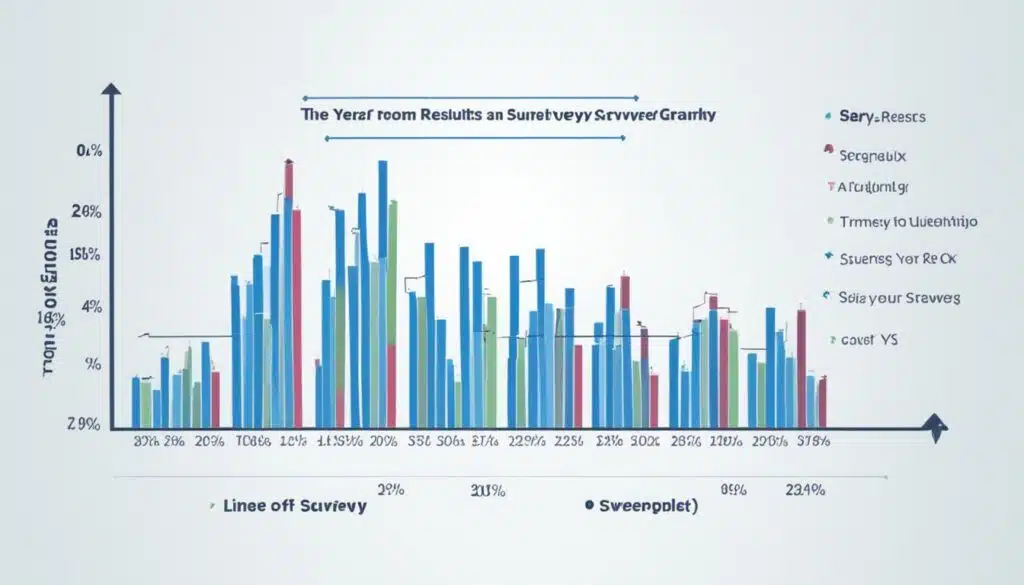
Surveys play a vital role in tracking changes over time in attitudes, opinions, and behaviors. To achieve this, researchers utilize two primary survey designs: cross-sectional and panel surveys.
Cross-sectional surveys compare different individuals within the same population at multiple points in time. This design allows researchers to examine changes in a group over time and uncover trends in their responses. On the other hand, panel surveys follow the same individuals over a specified period, providing a deeper understanding of how their attitudes and behaviors evolve.
When analyzing trends, it is crucial to maintain consistency in question wording and sequencing. This ensures that the survey data remains comparable across different time points, enabling accurate measurement of change over time.
To exemplify the significance of measuring change over time, Pew Research Center utilizes trending data to analyze shifts in the general public’s views. By carefully accounting for changes in survey methodology, such as transitioning from phone to online surveys, Pew Research Center avoids misleading trends and provides valuable insights into societal changes.
Survey data analysis is a critical step in understanding trends and patterns over time. Researchers employ statistical techniques, such as regression analysis and time series analysis, to identify significant changes and draw meaningful conclusions from the data.
In conclusion, tracking changes over time through surveys allows researchers to gain valuable insights into societal shifts, attitudes, and behaviors. By employing survey methodology best practices and analyzing trending data, researchers can contribute to the existing body of knowledge and make informed decisions based on reliable information.
Trending Data in Surveys: A Case Study
“The Pew Research Center’s ongoing surveys on political attitudes and demographic trends showcase the power of measuring change over time. By analyzing survey data collected from a diverse range of individuals at different points in time, the center uncovers evolving societal trends and provides comprehensive insights.”
| Survey Year | Response Rate | Sample Size |
|---|---|---|
| 2010 | 62% | 1000 |
| 2015 | 55% | 1500 |
| 2020 | 50% | 2000 |
Writing Effective Questionnaire Items: Tips for Optimal Responses
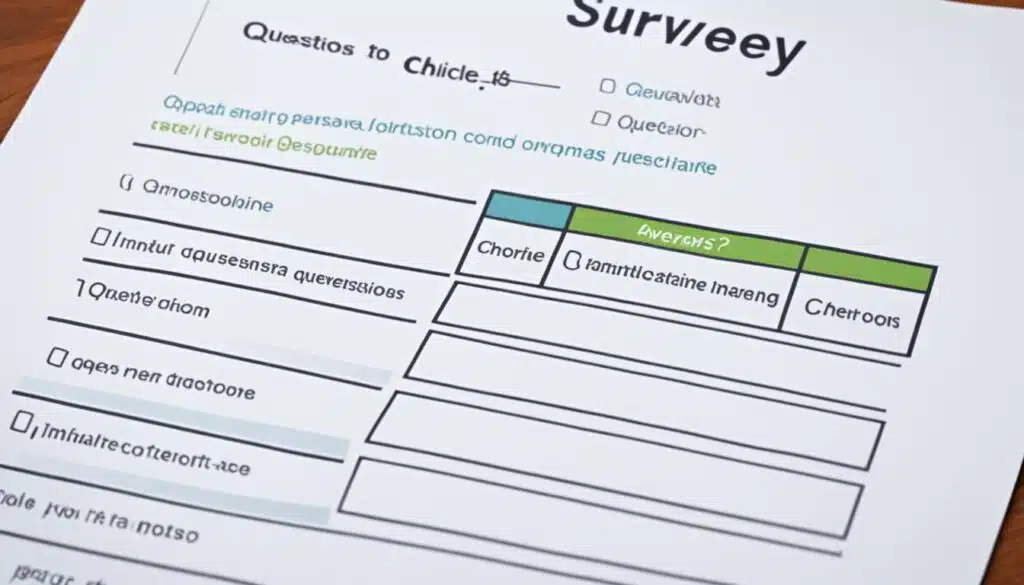
Developing a well-designed survey questionnaire is essential for collecting high-quality survey responses. To ensure optimal responses, it is important to consider various factors, such as the respondent’s answering process, question wording, and response options.
The Respondent’s Answering Process
When crafting survey questions, it is crucial to understand the process respondents go through when answering. They typically read the question, understand its purpose, retrieve relevant information from memory, form a judgment or opinion, and then select an appropriate response option.
Tip: To facilitate this process, use clear and concrete language in your questionnaire items. Avoid complex wording or technical jargon that may confuse respondents.
Different Types of Respondents
Keep in mind that different respondents may approach surveys differently. Some individuals are “optimizers,” who carefully consider all options before selecting a response. Others are “satisficers,” who tend to choose the first satisfactory option that comes to mind. Designing your survey to accommodate both types of respondents can help ensure accurate and meaningful responses.
Question Wording
Clear and unambiguous question wording is crucial for obtaining accurate survey responses. Begin by stating the question clearly and concisely. Use simple language that is easily understood by your target audience. Avoid using double negatives or leading questions that may bias respondents’ answers.
Tip: Consider pre-testing your questionnaire with a small sample of respondents to identify any potential issues with question understanding or wording.
Response Options
Well-structured response options are essential for capturing accurate survey data. Ensure that your response options are exhaustive and mutually exclusive, meaning that they cover all possible choices and do not overlap. This allows respondents to select the option that best aligns with their views, opinions, or experiences.
Consider using agree/disagree scales for attitudinal questions and rating scales for measuring intensity or frequency. These types of response options provide a range of choices and can enhance the accuracy and granularity of the data collected.
Tip: Randomizing the order of response options can help minimize order bias and ensure more reliable results.
By following these tips and considering the respondent’s perspective, you can create a survey questionnaire that maximizes response quality and delivers valuable insights.
Enhancing Question Clarity and Comprehension
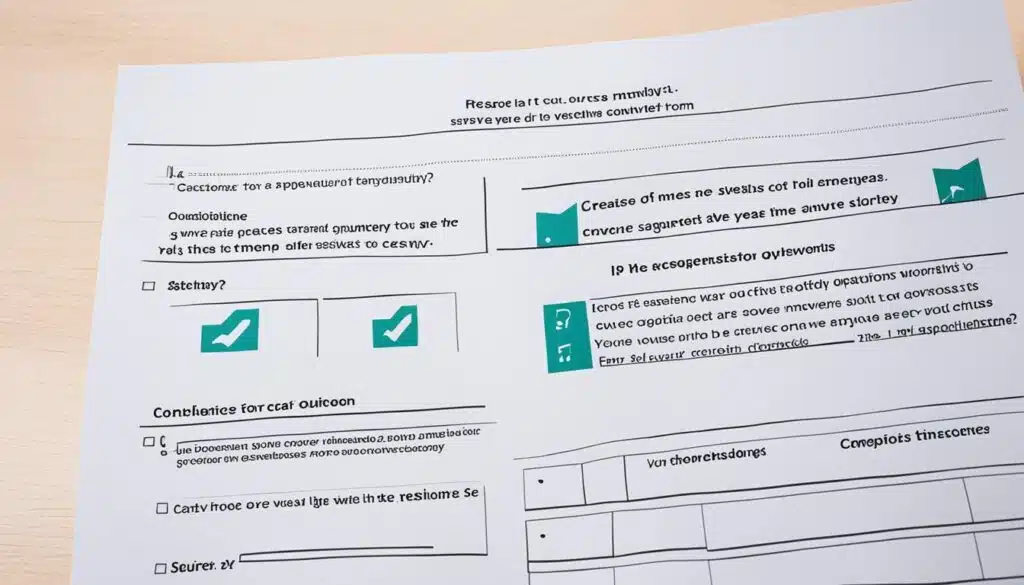
When it comes to survey research, clear and precise language is the key to obtaining accurate and insightful results. By crafting clear survey questions, you can minimize respondent confusion and enhance the overall quality of the data collected. Here are some tips to help you improve question clarity and comprehension:
- Be Direct: Ask questions that focus on specific situations or behaviors rather than vague or abstract concepts. Direct questions elicit more accurate and meaningful responses.
- Avoid Leading Questions: It is important to avoid leading or biased questions that may steer respondents toward a particular answer. Keep your questions neutral and objective to maintain survey integrity.
- Use Simple Language: Use clear and easy-to-understand terminology that is familiar to your target audience. Avoid using industry-specific jargon or complex language that may confuse respondents.
- Focus on One Topic: Make sure each question addresses only one topic at a time to maintain clarity and avoid overwhelming the respondents. Multiple topics in a single question can lead to confusion and may result in inaccurate responses.
By implementing these strategies, you can ensure that your survey questions are clear, concise, and easily comprehensible for your respondents. This will ultimately lead to more accurate and reliable data that can be used to inform your research and decision-making processes.
Take a look at the example below to see how the use of clear language and direct questions can enhance question clarity and comprehension:
“Do you think brand X is better than brand Y?”
“How likely are you to recommend brand X to a friend or colleague?”
As you can see, the second example focuses on a specific behavior (recommendation) and avoids leading the respondent towards a specific answer. This approach reduces confusion and provides more meaningful insights.
Example: Enhancing Question Clarity and Comprehension
| Question | Clarity Level |
|---|---|
| How satisfied are you with the customer service you received? | Clear |
| Do you think our product is the best in the market? | Leading Question |
| On a scale of 1-10, how likely are you to recommend our services to others? | Clear and Direct |
| What do you think about our new website design and user interface? | Multitopic |
Survey Question Order and Layout
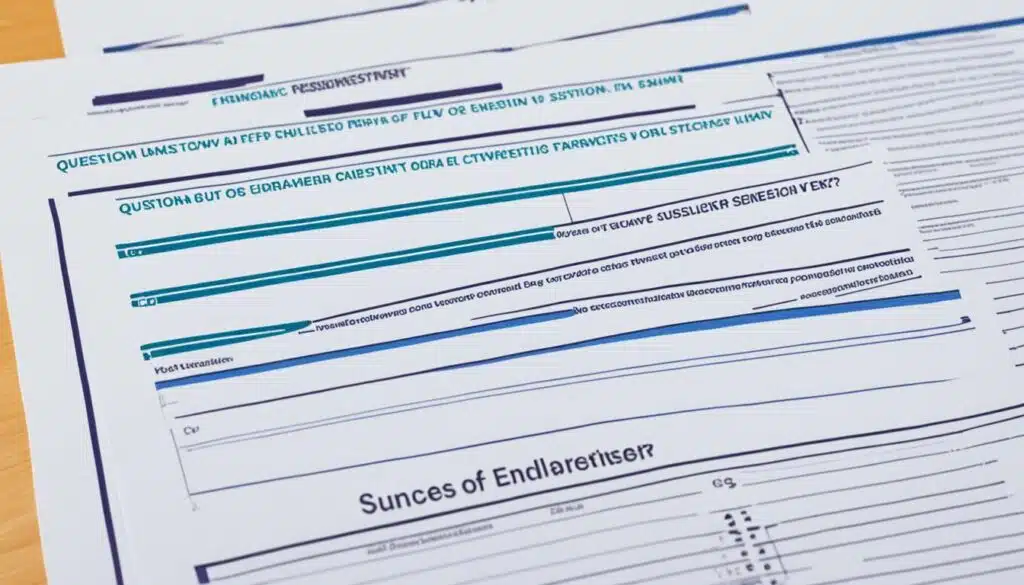
The order and layout of survey questions play a crucial role in influencing respondents’ understanding and their subsequent responses. It is important to optimize the survey layout to ensure a logical flow and improve respondent engagement. By structuring the questions in a thoughtful order and organizing them by topic, researchers can enhance participants’ comprehension and accuracy in their answers.
An effective approach for self-administered surveys is to begin with easy and less sensitive questions before gradually progressing to more complex or sensitive topics. This gradual transition allows respondents to ease into the survey and build trust, increasing their willingness to provide accurate responses. It is recommended to follow a logical sequence that aligns with the natural progression of the research objectives.
Grouping questions by topic is another strategy to consider. This approach provides context for the respondents, making it easier for them to understand and respond to related questions cohesively. By organizing questions into sections or subsections, participants can maintain focus and better grasp the overall flow of the survey.
Randomizing the order of response options is also a valuable technique to minimize order effects. Order effects occur when respondents tend to choose a particular response option due to its position in the list. Randomization helps spread any potential bias across different respondents, resulting in more accurate and unbiased data.
Demographic questions, such as age, gender, or income, should ideally be placed towards the end of the survey. This positioning mitigates the risk of participants engaging in satisficing behavior, where they provide hurried or careless responses to expedite the survey completion process. By saving these questions for later, respondents are more likely to engage thoughtfully and provide accurate demographic information.
Benefits of Optimizing Survey Question Order and Layout:
- Enhanced respondent engagement and understanding
- Increased accuracy and quality of responses
- Minimized order effects and biased responses
- Improved data integrity and reliability
By strategically designing the survey question order and layout, researchers can maximize the effectiveness of their surveys and obtain valuable insights from participants. The optimal arrangement of questions ensures a logical flow and minimizes respondent fatigue, resulting in higher quality data and more informed research outcomes.
Pre-Testing and Cognitive Interviewing: Ensuring Survey Validity

Before distributing a survey, it is essential to conduct pre-testing to ensure its validity and identify any potential issues. Pre-testing involves evaluating the clarity of survey questions and understanding how respondents interpret them. One effective method is cognitive interviewing, which provides valuable insights into the thought processes underlying respondents’ answers.
Cognitive interviewing techniques, such as thinking aloud, encourage respondents to verbalize their thoughts as they navigate through the survey. This allows researchers to gain insights into how participants interpret and understand the questions. Additionally, probing for comprehension helps uncover any areas of confusion or potential misinterpretation.
Another approach to survey pre-testing is reviewing the survey with individuals who resemble the target population. This step ensures that the questions resonate with the intended respondents and provides an opportunity to receive feedback on the overall survey design and question comprehension.
Online tools, such as the Question Understanding Aid, can be used to gather feedback on the survey. These tools help assess question clarity and identify any potential problems that need to be addressed. By incorporating feedback and making necessary revisions, the validity of the survey can be enhanced.
Taking the time to pre-test and refine a survey is crucial for ensuring the quality and accuracy of the data collected. Through cognitive interviewing and feedback from target population representatives, researchers can improve question comprehension, minimize respondent confusion, and enhance the validity of the survey instrument.
| Benefits of Pre-Testing and Cognitive Interviewing | Actions |
|---|---|
| Identify potential issues with question understanding | Conduct cognitive interviews and observe respondents’ thought processes |
| Evaluate question clarity | Review the survey with individuals similar to the target population |
| Refine survey design | Incorporate feedback from target population representatives |
| Enhance survey validity | Utilize online tools for question feedback, such as the Question Understanding Aid |
Best Practices for Writing Effective Surveys

When it comes to survey design, following best practices is essential to ensure accurate and reliable data collection. By implementing effective survey design techniques, you can enhance respondent engagement, improve comprehension, and maximize the quality of survey responses.
Keep Surveys Short and Simple
Long and complex surveys can lead to respondent fatigue and reduced data quality. To maintain engagement, it’s important to keep surveys concise and focused. Short surveys are more likely to be completed and yield higher response rates. By prioritizing essential questions and avoiding unnecessary or redundant content, you can make your survey more efficient and effective.
Provide Clear Instructions and Context
Clarity is key when it comes to survey instructions and question context. Clearly articulate the purpose of the survey and explain why the respondent’s input is valuable. Make sure each question is accompanied by concise and explicit instructions. By providing clear guidance, you can ensure that respondents understand what is being asked and can provide accurate and meaningful responses.
Use Plain Language and Avoid Technical Jargon
When crafting survey questions, it’s vital to use language that is accessible and easily understood by the target audience. Avoid complex terminology or industry jargon that may confuse or alienate respondents. Opt for plain language that is clear, concise, and widely accessible. By using simple and straightforward wording, you can improve respondent comprehension and enhance the reliability of the collected data.
Select Response Scales Carefully
The design of response scales can significantly impact the accuracy and reliability of survey responses. When selecting response options, consider using balanced scales that provide a range of choices and accurately capture respondent attitudes or opinions. Avoid using overly complex or convoluted scales that may introduce bias or confusion. By carefully designing response scales, you can facilitate accurate responses and enable meaningful data analysis.
Avoid Grid Questions
Grid questions, which present multiple questions with the same set of response options in a table format, can introduce cognitive burden and fatigue for respondents. Instead of using grid questions, consider breaking them into individual questions. This approach allows respondents to focus on one question at a time, reducing cognitive load and improving response accuracy.
Optimize Question Order and Layout
The order and layout of survey questions can impact respondent comprehension and engagement. Structure your survey with a logical flow, starting with easy and non-sensitive questions before gradually progressing to more complex or sensitive topics. Group related questions together to provide context and make it easier for respondents to understand the purpose and relevance of each set of questions. Randomize response options to minimize order effects and maintain data integrity.
By following these best practices for effective survey design, you can create surveys that are engaging, easy to understand, and yield high-quality data. Remember, clear instructions, concise questions, and a thoughtful layout are key to optimizing respondent experience and obtaining accurate insights.
Language Considerations in Survey Design
![]()
Using language that the respondents understand is crucial for effective survey design. By employing plain and straightforward language, survey creators can enhance respondent comprehension and engage a wider audience. It is essential to avoid using technical jargon that may confuse or alienate respondents. Keeping sentences concise and avoiding complex sentence structures can further improve understanding.
Survey questions should strike a balance between simplicity and accuracy. While it is important to use plain language, care must be taken not to oversimplify questions to the point where their meaning is altered or important details are omitted. Clear instructions, explanations, and examples can help respondents provide accurate and meaningful survey responses.
Adapting the language to the target audience is key in survey design. The survey questions should be framed in a way that resonates with the cultural and linguistic background of the respondents. This may involve using specific terminology or phrasing that is commonly used and understood by the target population.
Furthermore, survey design should ensure that clear and unambiguous questions are presented to the respondents. Ambiguity or vagueness in survey questions can lead to varying interpretations and unreliable data. Therefore, it is essential to carefully craft questions that are concise, specific, and directly address the information being sought.
Example:
Question:
Do you like the new XYZ product? Yes or No?
Compared to:
How would you rate your satisfaction with the new XYZ product on a scale of 1 to 5, with 1 being extremely dissatisfied and 5 being extremely satisfied?
The second question provides clearer instructions and a more defined response scale, allowing respondents to more accurately convey their opinion.
By considering language factors in survey design, including the respondent’s language, plain language, and clear survey questions, researchers can optimize respondent comprehension and improve the overall quality of survey responses.
Utilizing Response Scales and Avoiding Biases
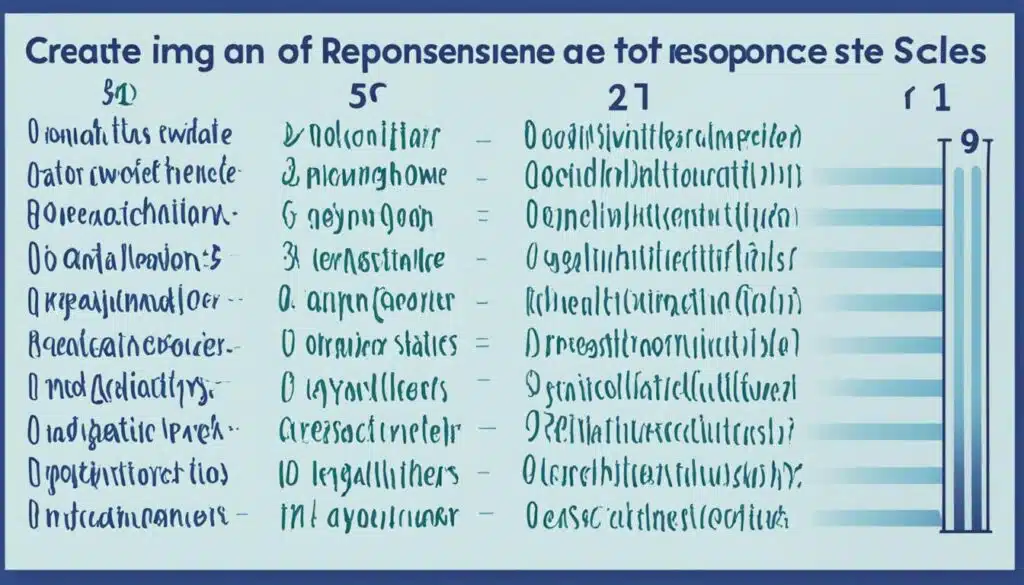
Response scales are a valuable tool in survey research as they capture the direction and intensity of attitudes, allowing for richer data analysis. When designing surveys, it is crucial to use clear and balanced response options to avoid biases and enable meaningful comparisons.
Avoiding leading or loaded language in survey questions is essential to ensure that respondents’ answers reflect their true opinions or behaviors. By incorporating well-defined response scales and eliminating biases, survey designers can obtain reliable and valid data.
Clear and Balanced Response Options
When constructing response scales, it is important to provide clear and balanced options that accurately capture respondents’ opinions or experiences. This allows for the collection of unbiased data and enhances the validity of survey findings.
Using response scales that cover the full range of possible responses, such as a Likert scale from “strongly disagree” to “strongly agree,” ensures that respondents can express their true sentiments. Opting for balanced scales, where positive and negative responses are equally represented, prevents skewing of results and produces more accurate data.
Avoiding Biases in Survey Questions
Biases in survey questions can influence respondents’ answers and compromise the integrity of the data. To mitigate biases, survey designers should steer clear of leading language that prompts respondents to lean towards a particular response.
“How much do you agree with the extremely popular and widely accepted opinion that XYZ product is absolutely amazing?”
The example above contains loaded language and a leading question, potentially skewing responses towards a positive opinion of the product. Instead, survey questions should be presented in a neutral and unbiased manner:
“Please rate your satisfaction with XYZ product.”
Using neutral language in survey questions allows respondents to provide honest and unbiased feedback, resulting in more accurate data.
Reliable and Valid Data
By incorporating clear response scales and avoiding biases, survey designers can obtain reliable and valid data that accurately reflects respondents’ opinions, attitudes, or behaviors. This data can be instrumental in informing decision-making processes, driving improvements, and shaping strategies.
| Response Scale | Definition |
|---|---|
| 1-5 Rating Scale | A scale where respondents rate their agreement or satisfaction using numbers from 1 to 5, with 1 representing the lowest and 5 representing the highest rating. |
| Multiple Choice Scale | A scale where respondents choose one option from a list of predefined choices, allowing for easy comparison and analysis. |
| Sliding Scale | A scale that presents a continuum or spectrum of options, allowing respondents to indicate their level of agreement or preference by selecting a point along the scale. |
| Ranking Scale | A scale where respondents rank items based on their importance, preference, or priority, providing insights into relative preferences. |
Also Read : Earnings With Affiliate Marketing Mastery
Conclusion
Survey methodology plays a crucial role in ensuring the accuracy and reliability of research results. By following best practices in questionnaire design, question development, survey pre-testing, and data analysis, researchers can enhance the quality of survey responses.
Considering the respondent’s perspective is key. Using clear and direct language, and structuring surveys in a logical and engaging manner are essential factors in optimizing survey design. These practices help respondents understand the purpose of the survey and provide accurate responses.
Implementing these survey methodology best practices leads to more accurate and informative research outcomes. Researchers can rely on the data collected to make informed decisions and draw valid conclusions. By prioritizing survey methodology, researchers can ensure the integrity and effectiveness of their research endeavors.
FAQs
Q: What are some key factors to consider for accurate data collection in survey research?
A: Key factors to consider for accurate data collection in survey research include using valid and reliable data collection instruments, ensuring a representative sample, minimizing sources of error such as nonresponse and measurement error, and employing proper sampling methods.
Q: How can researchers ensure the representativeness of their sample in survey methodology?
A: Researchers can ensure the representativeness of their sample in survey methodology by using a large sample size, considering demographic characteristics when selecting participants, and conducting follow-up efforts to minimize nonresponse error.
Q: What role does an interviewer play in the survey methodology process?
A: Interviewers play a crucial role in survey methodology by administering surveys, building rapport with respondents to encourage accurate and honest responses, and ensuring data collection is done properly according to research methods.
Q: How can researchers minimize nonresponse error in survey research?
A: Researchers can minimize nonresponse error in survey research by conducting follow-up efforts with nonrespondents, utilizing multiple modes of survey administration (e.g., telephone surveys), and adjusting for potential biases caused by non-response.
Q: What are some common modes used in survey research for data collection?
A: Common modes used in survey research for data collection include telephone surveys, self-report questionnaires, face-to-face interviews, and online surveys.
Q: What is the importance of using valid and reliable data collection instruments in survey methodology?
A: Using valid and reliable data collection instruments in survey methodology is crucial for ensuring that the data collected accurately reflects the research objectives and can be used to draw meaningful conclusions.
Q: How can researchers adjust for sources of error in survey research?
A: Researchers can adjust for sources of error in survey research by implementing proper sampling techniques, conducting robust data analysis to identify and address potential errors, and utilizing techniques such as weighting and statistical adjustments.
Q: What are some key research methods used in survey methodology?
A: Common research methods used in survey methodology include quantitative research, comparative studies, cross-national surveys, and literature reviews.
Q: How important is the representativeness of the sample in survey research?
A: The representativeness of the sample is crucial in survey research as it ensures that the findings can be generalized to the larger population being studied.
Q: How do you determine the size of the sample for a survey?
A: The size of the sample is determined based on factors such as the confidence level, margin of error, and the variability of the population being studied.
Q: What is the role of a sampling frame in survey methodology?
A: A sampling frame is a list of all the elements in the population from which the sample is drawn, ensuring that every member of the population has an equal chance of being selected.
Q: How can you minimize response bias in survey research?
A: Response bias can be minimized by ensuring the questions are phrased neutrally, using randomization techniques, and providing anonymity to respondents.
Q: What are some common tools used for conducting surveys?
A: Surveys can be conducted using tools such as phone calls, online platforms like SurveyMonkey, face-to-face interviews, and mailed questionnaires.
Q: How do you address coverage error in survey methodology?
A: Coverage error can be addressed by ensuring the sampling frame is comprehensive and includes all elements of the population without any omissions.





